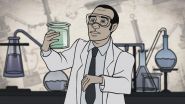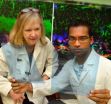Now, a research team led by investigators at Beth Israel Deaconess Medical Center (BIDMC) finds that naturally occurring carbon monoxide (CO) is essential for the macrophages' carefully crafted surveillance plan and subsequent attack. In a study appearing in the November issue of The Journal of Clinical Investigation (JCI), the researchers describe a scenario in which CO conducts reconnaissance for immune cells, working to detect the presence of bacteria and subsequently instigating a series of maneuvers that enable the immune cells to unleash their attack on the microbes.
The new findings support the possibility that in the future, small, non-toxic doses of carbon monoxide could be used therapeutically to provide the immune system with an infection-fighting advantage and to potentially complement the use of antibiotics as the standard of care for bacterial infections.
"Nature has crafted a careful system to fight infections," says senior author Leo E. Otterbein, PhD, an investigator in the Division of Transplantation in BIDMC's Department of Surgery and Associate Professor of Surgery at Harvard Medical School (HMS). "In battling bacteria, the immune system conducts a two-step signaling process. This ensures that immune cells become fully activated only when confronted with live bacteria; when presented with bacterial fragments, such as the lipid polysaccharides present on bacteria's outer walls, immune cells become only mildly stimulated. This distinction conserves energy and helps the immune cells to maintain an efficient defense system. We now see that CO plays a critical role in the execution of this two-step process, enabling the immune cells to successfully carry out their attack."
Otterbein has been studying carbon monoxide for more than 12 years and his novel studies have revealed promising therapeutic applications for the gas, including treatment of pulmonary hypertension, prevention of organ rejection following transplantation, reduction of vascular restenosis and, most recently, shrinkage of cancerous tumors. Clinical trials to test inhaled CO for the treatment of lung disease, intestinal dysfunction and organ transplantation are currently underway -- the direct result of Otterbein's pioneering work.
"The body naturally generates CO through the increased expression of heme oxygenase-1 [HO-1] a cytoprotective stress response gene," he explains. "We've known that HO-1 is highly induced in macrophages in response to bacterial infection. We, therefore, hypothesized that CO, generated by HO-1, was acting as a scout for the innate immune system and was somehow providing the signal to the macrophages that bacteria was present and it was time to attack."
Led by first author Barbara Wegiel, PhD, an investigator in BIDMC's Division of Transplantation and Assistant Professor of Surgery at HMS, the team embarked on a series of experiments using mouse models of sepsis (a dangerous complication of infection) to test CO against Gram Positive and Gram Negative bacteria, as well as Mycobacteria tuberculosis. The team also made use of novel bacterial strains that were mutated such that they were unable to respond to CO in order to elucidate potential targets where CO was imparting its effects.
"The animals for which HO-1 was blocked were exquisitely sensitive to bacteria and exhibited classic signs of systemic inflammatory response syndrome [SIRS], a complication of bacterial infections that can ultimately lead to multi-organ failure and death," says Wegiel. "But when treated with CO -- hours after the infection had taken hold - the animals could be rescued from the infection. CO appeared to be boosting the immune response to enhance clearance of the bacteria and resolution of the ongoing SIRS."
How was this happening?
Subsequent experiments in cell culture and confirmed in animal models revealed the mechanisms underlying the immune cells' two-step process.
"It turns out that the first signal - which puts white blood cells on alert without engaging them to become fully activated - causes HO-1 to generate CO inside the cell," says Wegiel, adding that the macrophages next send the CO outside the cell, in the form of a gas, to determine if a live bacteria actually exists in the region. If no active bacteria is present, the CO dissipates. But if dangerous microbes are lurking, the CO takes on a new responsibility and attaches itself to specific locations on the bacteria.
"When CO comes in contact with bacteria, it adheres to the protein complexes that compel the bacteria to uncharacteristically release adenosine triphosphate or ATP, a powerful signaling molecule involved in energy production for which specific receptors exist on the surface of the macrophages," says Otterbein. And this, he explains, serves as the second signal to alert the immune cells to take action. "This giant burst of ATP leads to the macrophages themselves becoming super activated, but also leads to their calling in greater numbers of the hosts' white blood cell forces because now it's clear there's a real infection to be fought."
The discovery unveils a new concept and offers a new avenue for the development of therapies to complement or potentially reduce the need for antibiotics and thus limit the development of antibiotic resistance, say the authors.
"CO can now be added to the list of cellular mechanisms that macrophages use to defend the host," says Otterbein. "CO clearly helps the immune cells to produce a faster and more robust response against bacteria. From a clinical perspective, one could envision CO being administered to patients with ongoing infections to help reduce the risk of dangerous complications, such as sepsis, SIRS and, ultimately, multi-organ failure. Our hope is that we will be able to test these applications in clinical trials and provide the body with a new weapon of mass destruction - one the host employs against invading armies of bacteria."
INFORMATION:
In addition to Otterbein and Wegiel, coauthors include BIDCM investigators David Gallo, Beek Yoke Chin, Clair Harris and Elzbieta Kaczmarek; Rasumus Larsen and Miguel P. Soares of Instituto Gulbenkian de Ciencia, Oeiras, Portugal; Paraveen Mannam and Patty J. Lee and Richard Flavell of Yale University School of Medicine; and Brian S. Zuckerbraun of the University of Pittsburgh Medical Center.
This work was supported by the following grants from the National Institutes of Health: HL-071797; HL-076167, R21CA169904-01, and HL-106227, as well as grants from the American Heart Association. Richard Flavell is an investigator of the Howard Hughes Medical Institute.
Beth Israel Deaconess Medical Center is a patient care, teaching and research affiliate of Harvard Medical School, and currently ranks third in National Institutes of Health funding among independent hospitals nationwide.
BIDMC is in the community with Beth Israel Deaconess Hospital-Milton, Beth Israel Deaconess Hospital-Needham, Beth Israel Deaconess Hospital-Plymouth, Anna Jaques Hospital, Cambridge Health Alliance, Lawrence General Hospital, Signature Healthcare, Beth Israel Deaconess HealthCare, Community Care Alliance, and Atrius Health. BIDMC is also clinically affiliated with the Joslin Diabetes Center and Hebrew Senior Life and is a research partner of Dana-Farber/Harvard Cancer Center and The Jackson Laboratory. BIDMC is the official hospital of the Boston Red Sox. For more information, visit http://www.bidmc.org. END





